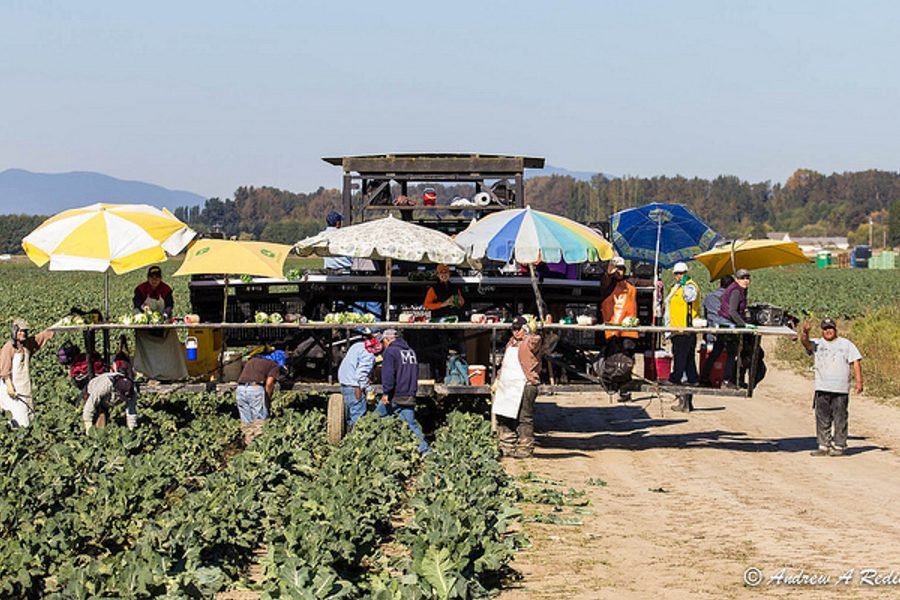
This article was first posted at Jacobin.
We live in the shadows,” explained Javier, a Hudson Valley farmworker, while describing his life to me. “We are treated like unknown people … We are not paid well and cannot ask for more.” A worker on another farm said, “They treat us like nothing; they only want the work … Whether we like it or not, we have to like it.”
Some of today’s liveliest political conversations concern agricultural production and distribution. But these discussions are also among the most confused.
Exploitative conditions on factory farms have rightly drawn the attention of academics, activists, and journalists. Indeed, the vast majority of research on farmworkers focuses on the largest farming sites. Consumers are offered countless reasons to avoid produce from them — but few alternatives other than to “buy local.”
Much contemporary food writing argues that when we buy locally grown food directly from farms, we not only secure fresher, more seasonal produce, but we also create an intimate, trusting relationship with the farmer. This supposed bond reinforces the common understanding that the local food production process is more wholesome than the industrial agricultural system.
Food writers and scholars have highlighted the many positive aspects of local food systems: economic and social justice, the sense of community facilitated by face-to-face interactions with food producers, and the civic engagement and democracy promoted by alternative agri-systems.
For example, as Barbara Kingsolver argues in Animal, Vegetable, Miracle, “‘locally grown’ is a denomination whose meaning in incorruptible.” Later in the book she addresses the poor pay and conditions of workers on factory farms, citing their average annual income of $7,500. Clearly, she intends readers to feel grateful that local farms offer a more just and well-paid alternative.
Or take another prominent example: in The Omnivore’s Dilemma, a landmark in the new food literature, Michael Pollan describes two types of farming — industrial and pastoral — and offers no in-between.
In promoting local diets as healthy and righteous alternatives to the capitalist-industrial monoculture food system, such writers have sold us an idea premised on a false dichotomy.
On one hand, they demonize factory farms for poisoning the land and local waterways, for confining and mistreating animals, and for exploiting their workers in the name of earning profits. On the other hand, they promote local agriculture as the antidote to the factory farms’ corporate ills.
By shopping at the farmers market or joining a Community Supported Agriculture (CSA) program, consumers support smaller (though not necessarily small) farmers, keep food dollars local, encourage limited pesticide use, and ensure animals are treated humanely.
Marked for exploitation
In their praise of small farms, food writers use terms like local, alternative, sustainable, and fair to distinguish local food production from the hated factory farm. But they often conflate these terms. And with all of the positive attention heaped on local farms, it is easy to imagine that these benefits extend to their workers.
But my research, dating back to 2000, reveals that working conditions on local farms in New York’s Hudson Valley are not very different from those on the factory farms that dominate the headlines.
Of the farm hands I met, 99 percent were foreign born. The vast majority, 71 percent, were non-citizen Latinos; 20 percent were on H-2A guest-worker visas and hailed from Jamaica or Latin America. Most of the Latinos spoke little English, had low literacy in their native languages, and, on average, received a sixth-grade formal education.
The lack of English skills actually benefits their employers, who see learning the language as a stepping-stone to becoming American. The problem with American workers, farmers told me, is that they don’t have a work ethic.
Hudson Valley farmworkers were not primarily migrant workers: they lived in New York year-round, even if their farm jobs were seasonal. About one-third of those I met also lived with their families. This family reunification counters the workers’ loneliness, but it also undermines their financial goals.
Manuel expounded on this point:
I currently have nothing. You make dollars, but here you spend dollars, not like at home where the money goes further. The situation would be different if I made money here and sent it back to my country, but my family is here. You honestly cannot save money here.
The workers reported even worse economic exploitation in their home countries: age discrimination in factory work, bosses who paid in food, and subsistence living.
One comment raised both environmental issues and the retraction of irrigation programs and farm subsidies in Mexico post-NAFTA: “I used to have my own potato farm, but there is no water. Nothing happens with land that is dead.”
Those I spoke to also described their fear of losing their jobs or being deported. They also did not know their rights.
These factors, coupled with their desire to return home, created a vulnerable workforce willing to make tremendous sacrifices. To protect vital income for their families, they kept their heads down, set aside concerns about their own well-being, and complied with employer demands.
Many acutely analyzed their positions — they were utterly dependent on farm wages, lonely, and alienated.
A twenty-two-year-old Guatemalan woman broke into tears when she described how much she missed her home. She spoke to her mother often over the phone, but said she never related her sadness or complained about the work. Like others I interviewed who downplayed their hardships, her goal was to optimize her income even as she was painfully aware of her meager earning potential.
The work they perform is difficult, dirty, and strenuous; it requires repeated bending or crouching, sometimes with sharp implements, and sometimes in extreme weather for long hours. “You are dead by the end of the day; your arms and your feet ache because of standing all day,” one worker said.
A field hand told me he thought dogs were treated better than he was. But then he got worried that he was telling me too much. Many workers were reluctant to share stories about their working conditions, using phrases like “I better not say” and expressing fear of reprisals.
There are stories of wage theft, human trafficking, sexual harassment, illegal firings, and intimidation. But even if employers were prosecuted for such violations of existing law, the job would still exploit workers.
In New York — as in most other states—farmworkers do not have a right to a day of rest, they do not have a right to overtime pay, and they do not have a right to collective bargaining.
This means that some work eighty to ninety hours a week, for minimum wage, sometimes over seven days. Farmworkers argue that the law sets them up for exploitation since it fails to recognize them as equal to other workers. Heriberto, a farmworker who has given public talks, tells New Yorkers that they should be embarrassed by these laws.
Workers’ disempowerment in the workplace is the most critical issue they face. While getting paid for hours worked is the most basic element of the labor contract, many farmworkers reported that their paychecks would arrive missing several hours. But, like many of the most vulnerable laborers, they were too afraid to say anything.
The price of proximity
The farmer-worker relationship on small farms takes the form of a complicated kind of paternalism, which I call the price of proximity. This paternalism serves as an important way to control labor.
It is the flip side of the intimacy consumers imagine they share with local, smaller-scale farmers. On the farms I visited, labor contractors were few, and there were no middle managers. As a result, farmers were in direct relationship with their workers.
Paternalism exists when the boss oversees some aspect of a worker’s life outside the labor relationship — like when a farmer houses workers. What my research revealed, however, were deeper levels of this relationship.
Farmers gave their workers excess produce or the use of farm vehicles, allowed their families to live with them, protected them from local authorities, and made vague promises— perhaps a green card or the prospect of land.
These benefits served workers well, yet none of them were codified in the labor contract. And there’s the rub — employees must act like “good workers” if they want to continue receiving these perks.
An apple picker nicely summed up the complexity of paternalism. When I asked how he would deal with a workplace problem, he responded, “Honestly, I wouldn’t know what to do, because the boss is a good person and gives us a home and doesn’t charge us rent.”
The price of proximity derives directly from the intimate relationships developed on the farm. And workers understand they can never “pay back” these benefits, except with their quiescence.
These conditions rarely come up in discussions about locally sourced foods. We don’t think about workers on local farms. Instead, we assume these farms are mom-and-pop operations, or imagine that farm laborers have the sustainable jobs that the local food movement has promised.
We have oversimplified alternative agriculture’s economy, while glorifying the ethos of family farming. As a result, we have largely ignored farmworkers.
Taught to be quiet
Whether they were undocumented or guestworkers, Luis summed up a sentiment I heard repeatedly: “If you behave there is work”
My interviews revealed that farmworkers feared employer retaliation. A service provider I spoke to described his same experience: “They usually signal with their finger going across their throat, signaling that their head will be chopped off — not meaning that in reality, but that they won’t (be able to) come back.”
Since the threat of deportation is real, and since employers, by law, do not have to verify their employees’ documents, workers with false documents will try to limit their grievances to deflect attention from their legal status.
Javier eloquently summed up the predicament: “When I am alone, I think ‘even if the cage is golden we are still locked up.’ What good is it to earn dollars if we are locked up?”
One foodie acquaintance told me she didn’t have to worry about labor conditions on the CSA program she belonged to since the farmer employed guestworkers. But the guestworkers I interviewed would not agree.
Guestworkers repeatedly told me that they were “taught to be quiet.” They explained that if they joined a union or questioned their employment benefits, they would not be allowed to return to the United States.
These workers also felt exploited by the system as a whole: their home government takes a cut of the funds they earned. As a former guestworker put it: “They hire us out and they make a fortune. We make the least.”
These comments reveal not only that guestworkers are pressured to maintain good conduct, but also that they face institutionalized modes of labor discipline.
Romantic agrarianism’s long shadow
The food movement that shapes our thinking today is the latest revival of romantic agrarianism. The concept — which promotes the American romance with farming — is grounded in historic traditions from the country’s founding.
In The Age of Reform, Richard Hofstadter lays out romantic agrarianism’s three key mythologies: farmers are economically independent and self-sufficient; farming is intrinsically a natural and moral activity; and farming is the fundamental industry of society.
Romantic agrarianism is not only a formative component of American ideology, it also determines the political economy of food. What’s more, it does not have to be taught. Children are fed these lessons from a young age, starting with babies’ first board books.
Romantic agrarianism is particularly potent in the Hudson Valley, a fabled agricultural region. The region’s cultural identity trades on the currency of agrarian values and epitomizes precisely those farming sectors that have benefited most from the economic stimulus promised by alternative and local food movements.
Today, food writers play a critical role in shaping our understanding of farming. Too often they uncritically reproduce this romanticism and as a result obfuscate labor concerns. (To his credit, Michael Pollan has more recently encouraged foodies to consider worker conditions.)
Consider the following quote from an article in the foodie magazine Edible Hudson Valley: “Traditional agricultural values of generosity and cooperation, rooted in the Hudson Valley, seem infused in each batch of cheese produced.”
Food organizations should play an important role, but we need bold leaders. Last year, an New York City-based group approached me to organize a panel that would explore a different side of the farm labor issue. But after a bit of discussion, they dropped the event since the board was concerned about putting farmers on the defensive.
Real solidarity
Advocates for sustainable local food systems do not completely ignore labor concerns. Foodies and food writers have backed recent campaigns by workers on factory farms, including the Coalition of Immokalee Workers’s effort to pressure Wendy’s—along with fourteen other corporate food giants who purchase Florida’s fresh tomatoes — to join the Fair Food Program.
On the West Coast, Familias Unidas por la Justicia, a Washington State farmworker union, spearheaded a 2016 boycott of Driscoll’s berries. The boycott builds on a spring 2016 effort in Baja, Mexico where thousands of berry pickers went on a successful strike to improve their conditions and highlight Driscoll’s profits.
If we are sincere in our solidarity with farmworkers, we must pay equal attention to labor conditions at smaller farms. Organic produce is thriving because consumers said they wanted it; animals are treated better because consumers said they cared.
While supporting farmworker efforts against corporate giants is commendable, we also need look in our own backyards and confront our local farmers — which should be one of the benefits of intimacy.
And that’s only the start. Those concerned with the politics of food need to think more clearly than Kingsolver, Pollan, and the other avatars of the “locavore” movement about the range of problems contemporary farms, industrial and “pastoral” alike, face — and to be more sanguine about the limits of consumer activism.
The plight of hyper-exploited workers on small farms will remain hidden if activists continue to portray factory farming as a unique evil facilitated by some kind of spiritual disconnect from the land, rather than one particularly telling example of capitalism’s inhumanity.
There is much to admire about small, local farms. But any serious effort to address the food supply chain must be big and international.
Until there is a food movement that takes place on those terms, produce cultivated under fair labor conditions will stand for little more than “organic” and “cage-free” do now: the costly mark of good conscience available only to the small few who can afford it.
In These Times is proud to feature content from Jacobin, a print quarterly that offers socialist perspectives on politics and economics. Support Jacobin and buy a four-issue subscription for just $19.95.




